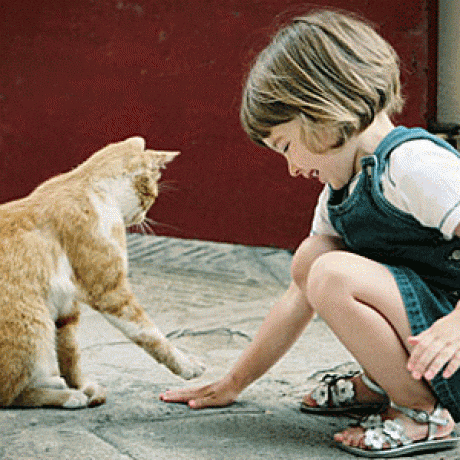What is Cat Socialization?
Cat socialization is the process of developing trust in your cat and acclimating her to people and other animals in the home environment. A cat who is not socialized can be timid, distrustful, scared or aggressive. A well-socialized cat is more likely to be loving, trusting, affectionate and well-behaved. It’s especially important to socialize your cat if you have young children in the house so that they won’t be scratched or bitten during play.
When choosing a cat, one who exhibits friendly and outgoing behavior is going to be easier to socialize. Older cats who haven’t been socialized will require a lot more time and effort to train, but it’s not impossible to do so.
If adopting a kitten, socialization is likely to be easier if you adopt a pair of kittens. They will keep each other company when you’re not around, and are less likely to engage in the type of destructive behavior that arises from boredom. Many shelters have bonded pairs available who need to go to the same home.
Your success at socializing your cat will vary depending on the cat’s innate personality and genetic makeup, and the amount of socialization she received prior to nine weeks of age.
Cat socialization need not take a lot of time. The more handling the better, but even short sessions of 15 minutes each day will help to gain your cat’s trust and put her at ease in your home.
Habituation and localization will also help make your cat a better pet. Habituation is the process of acclimating your cat to stimuli like sounds, smells and sights. Localization gets your cat accustomed to places like your home or office environment. Often, these are lumped together as part of socialization training.
How to Socialize a Cat
Handle Your Cat
Cats who have not been properly socialized can be suspicious and fearful. They might communicate this fear by biting and scratching. The key to quelling this fear is to acclimate your cat to handling so that she knows that nothing bad will happen when she’s in your arms.
Start slowly. Pet the cat in areas where she enjoys being petted – like the top of the head. Then, pick her up, stroke her feet with your fingertips, move on to the belly, the tail and the back. As you touch her, speak to her softly in a calm, low voice. If she becomes agitated, end the session and leave her alone.
If your cat engages in rough play during the session, tell her a firm “NO!” and put her down.
After a “touching” session, give her a treat. Continue to do this several times a day, extending the length of the sessions as your cat grows comfortable with you.
Extend the sessions to include handling of the feet and toes, including extending the nails. Open her mouth, and run your fingers across the gums. Stroke her ears. These exercises will help her win a “Good Kitty” award later when she is being groomed, examined by the vet, having her teeth brushed, or having her claws trimmed.
Screaming at your cat or hurting her will only increase her fear and distrust. Always approach and handle her calmly, and speak in a low soothing voice.
Play with Your Cat
Cats are predators by nature, and instinctively need to hunt and kill, even if only with a catnip mouse. Learn what your cat’s favorite type of toy is, and schedule playtimes several times daily. This can reduce the amount of misdirected predatory behavior (ankle attacks, etc.) in which your cat engages, and will help the two of you form a close bond.
As with the touching sessions, you should not reinforce bad behavior. If she attacks you during play, tell her “No!” and end the playtime.
Introduce Your Cat to Strangers
Be sure that the cat has your trust before you introduce her to strangers. Before you let other people handle your cat, make sure they know to keep their voices low and calm, at least until the cat is comfortable with them.
Let your cat come to them, and don’t force interaction. It may take a couple of visits before your cat is comfortable with people she doesn’t know.
If Your Cat Won’t Socialize
Be Patient
Socialization takes longer with some cats than others. Some can be socialized 95% of the way, but still may lash out with nips and scratches from time to time. Others may be inherently anti-social.
Be understanding and patient and respect the tiger within the tabby. Continue to reinforce good behavior and discourage unwanted behavior. Sometimes it will take years to fully complete the process, but you’ll be rewarded at the end with a housemate who enriches your life in ways you never expected.








